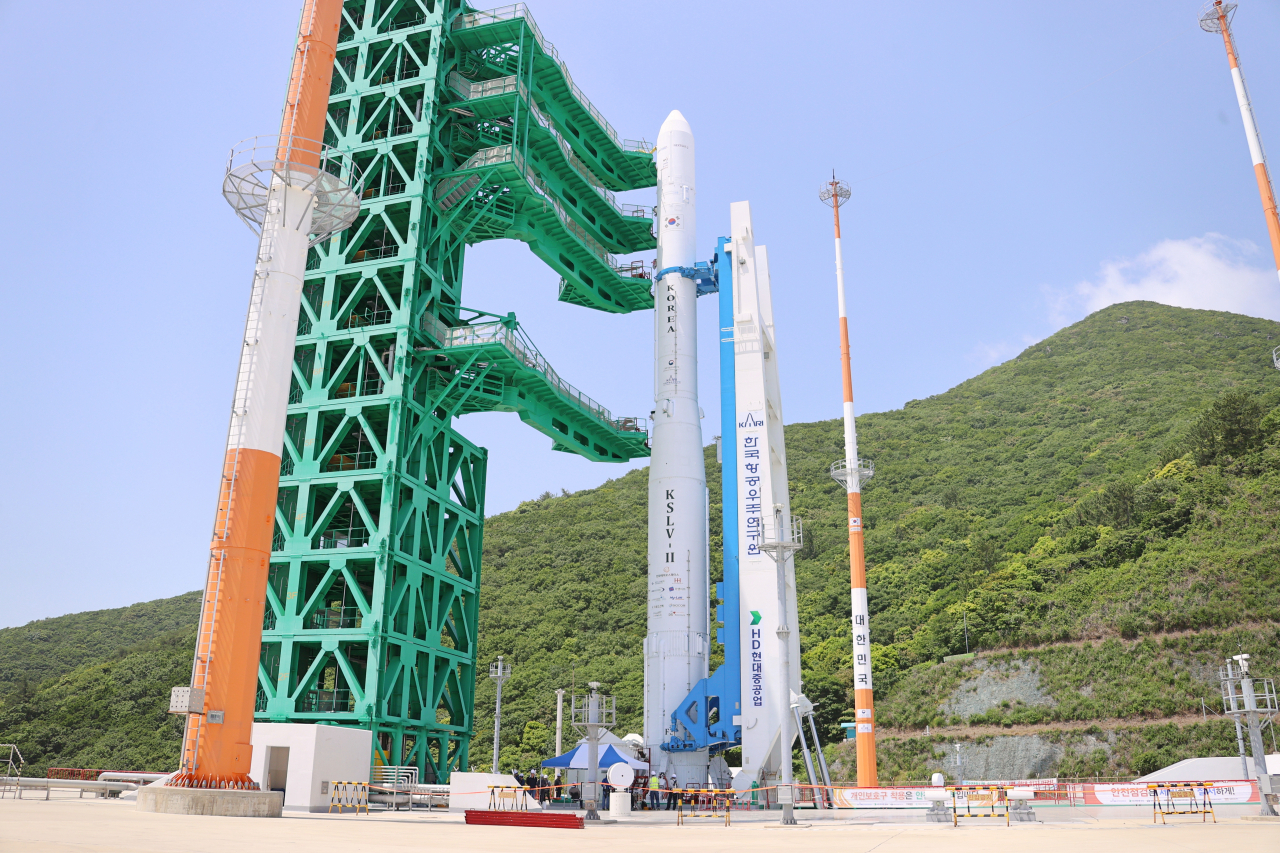Nuri rocket set for 3rd launch
Next-generation satellite mounted to test advanced space technologies
By Byun Hye-jinPublished : May 23, 2023 - 14:56

South Korea’s homegrown Nuri rocket, also known as the Korea Space Launch Vehicle-II, has begun the process to be positioned on a launch pad at the Naro Space Center in Goheung, South Jeolla Province, a day ahead of its third launch into space.
According to the Ministry of Science and ICT and the Korea Aerospace Research Institute, Nuri arrived at the launch pad an hour after it was transported from KARI’s assembly building at 7:20 a.m.
The rocket was being prepared to be erected vertically on the pad during the morning and for the prelaunch phase, including the charging process, by connecting to an umbilical to transfer gas, air and liquid coolant in the afternoon.
Unless any unusual glitches are discovered during the prelaunch checks, the rocket was likely to be installed at the launch pad before 7 p.m., the ministry said.
The Science Ministry will hold a meeting Wednesday to decide the launch time, taking into account the preparation level, launch window, weather forecasts and possibility of crashing into space objects.
The tentative blastoff schedule is set at 6:24 p.m. on the same day, though it is subject to change, the ministry said.
In June last year, when Nuri was gearing up for its second launch, it had a temporary setback due to technical glitches found during the final round of preparations. The launch date was postponed to June 21 from June 16, which had been delayed by one day due to strong wind.
After changing the necessary components, Nuri, in its second attempt, successfully entered the target orbit, making South Korea the world’s seventh country with indigenous capabilities to develop and launch a satellite greater than 1 ton.
Unlike the first launch which turned out to be a failure in 2021, the rocket was able to place a dummy satellite into its target orbit of 700 kilometers, proving it can carry up to 1.9 tons to low Earth orbit. It also dislodged a performance verification satellite, which completed its mission of carrying out two-way communication with the ground stations and sent four cube satellites made by local universities to space.
“Compared to the first and second launches that proved our developing capabilities, the third liftoff is more about advancing the technology,” said Lee Sang-ryool, president of the Korea Aerospace Research Institute, during a media briefing on May 7.
For the third journey to space, Nuri will carry a next-generation small satellite developed by the Satellite Technology Research Center at the Korea Advanced Institute of Science and Technology to test multiple space technologies, including synthetic aperture radar and space radioactivity observation, Lee added.
In addition to the satellite, seven cube satellites developed by the state-run Korea Astronomy and Space Science Institute and three private companies -- Lumir, Justek and Kairo Space -- will be put into orbit.
The small satellite is expected to enter into orbit at an altitude of 550 km from the rocket 13 minutes and nine seconds after liftoff, according to Ko Jeong-hwan, a KARI principal researcher and the current head of the Nuri rocket project. The seven cube satellites will be then in turn ejected from the rocket at 20-second intervals.
For the third and remaining three additional launches of the homegrown rocket, Hanwha Aerospace, which has been playing a key role in its development, will be leading the overall operation of the government’s space project.








![[Graphic News] More Koreans say they plan long-distance trips this year](http://res.heraldm.com/phpwas/restmb_idxmake.php?idx=644&simg=/content/image/2024/04/17/20240417050828_0.gif&u=)
![[KH Explains] Hyundai's full hybrid edge to pay off amid slow transition to pure EVs](http://res.heraldm.com/phpwas/restmb_idxmake.php?idx=644&simg=/content/image/2024/04/18/20240418050645_0.jpg&u=20240419100350)






![[From the Scene] Monks, Buddhists hail return of remains of Buddhas](http://res.heraldm.com/phpwas/restmb_idxmake.php?idx=652&simg=/content/image/2024/04/19/20240419050617_0.jpg&u=20240419175937)

![[KH Explains] Hyundai's full hybrid edge to pay off amid slow transition to pure EVs](http://res.heraldm.com/phpwas/restmb_idxmake.php?idx=652&simg=/content/image/2024/04/18/20240418050645_0.jpg&u=20240419100350)

![[Today’s K-pop] Illit drops debut single remix](http://res.heraldm.com/phpwas/restmb_idxmake.php?idx=642&simg=/content/image/2024/04/19/20240419050612_0.jpg&u=)